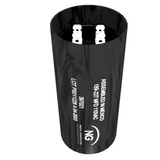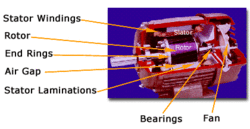What if we could shrink every electric motor in the world by two-thirds, essentially doing three times the work with the same juice?
We can. And we can do more than that. (Picture from NG Manufacturing.)
I got this story from an old college buddy out in West Texas. It seems a Mexican outfit, Neuva Generacion Manufacturing, which owns most of the big U.S. capacitor makers, has patented technology to do just this. It will first go into things like refrigerators and air conditioners, as well as industrial motors, but could be applied anywhere such motors operate.
How do they work? As my friend put it, the key to an electrical motor inefficiency lies in starting the thing. Current technology for starting motors increases the power demand by 300%. The capacitors allow start power to match the running power, so all that extra weight (and power use) goes away.
NGM has the capacity to serve the whole market, with factories in the U.S., Mexico and China. Among their brand names are Commonwealth Sprague, Barker, and Mallory.
To quote from their (admittedly poorly written) press release:
Early U.S. Department of Energy reviews of this new technology have demonstrated drastic improvements in life and dynamic improvements in most motor start applications. Manufacturing tests have proven that many major components of HVAC and Appliances can now achieve smaller overall size with resulting savings in materials and manufacturing costs when fully integrated with the new NG / PACCAP technology solutions.
The implications are discussed in an article at Copper.Org. Better capacitors mean more efficient motors, three times as efficient as current models. Even if the new motors merely replace old ones as they wear out, we’re talking about savings of:
62 to 104 billion kWh per year in the manufacturing sector alone. This savings is valued up to $5 billion. It would also avoid the release of up to 29.5 million metric tons of carbon equivalent emissions to the atmosphere annually.
Industrial motors consume about 23% of all electrical power in this country. Existing incentives for energy efficiency can increase the turnover rate, and the savings.
Now, how can we get even more savings?
By replacing relatively poor conductors like copper with better conductors such as carbon nanotubes, especially in small motors, we can double their efficiency. This is over-and-above the savings gained by going to new capacitors. (Electric motor picture from copper.org)
The challenge here lies in manufacturing the required carbon so that your finished product doesn’t cost much more than current designs. But with the rising cost of all energy, the break-even point on that is steadily falling. It can be done. We’re just talking about engineering here.
More important, by ramping up the production of carbon nanotubes, and spinning them efficiently into fiber, we gain the technology and scale needed for bigger jobs, like replacing current high-power lines made of steel with more efficient nanotubes, and even building a space elevator, which requires the kind of tensile strength only carbon nanotubes can provide.
When you’re feeling hopeless about the current energy crisis, think about this. By simply changing motors and adding carbon nanotube technology to our electrical grid, we can effectively increase our use of electricity by a factor of 10 without building a single power plant.
If we make it a point to first shutter our least environmentally-friendly power sources, like those which run on coal (without carbon sequestration) or oil, we can have dramatic impacts on our energy efficiency over the next decade.
And imagine what we could do if we really got serious about the War Against Oil?












